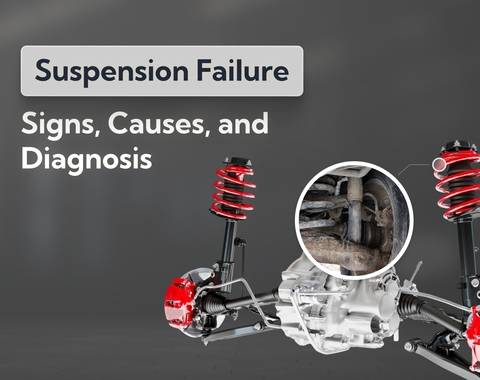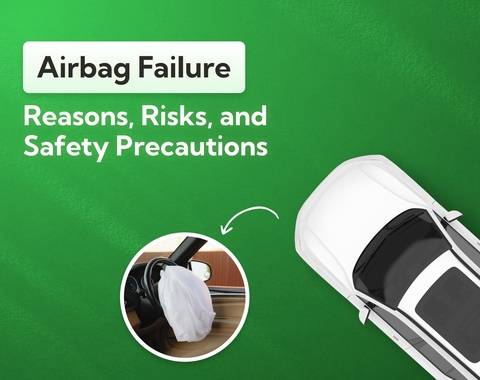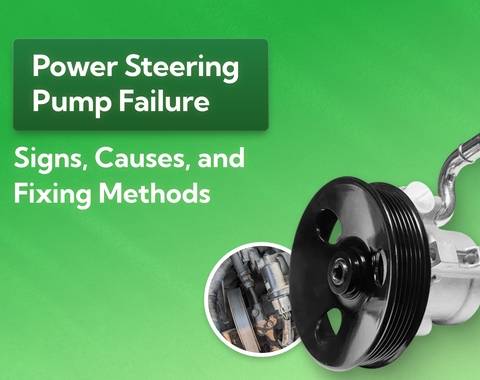12 Most Common MOT Fails (And How To Avoid Them)
Learn the 12 most common reasons UK drivers fail their MOT and find out how you can avoid them. Ensure your car passes the test on the first go.
Last updated: 6th October, 2025

Anthony Sharkey is COO at New Reg Limited (Car.co.uk, Trader.co.uk, Garage.co.uk), driving innovation in vehicle recycling, logistics, and customer experience.

Listen to this story
According to data published by the DVSA, 28.89% of the 8,245,954 passenger vehicles tested initially failed their MOT test in the months October through December alone.
Taking proactive measures to fix faulty parts of your car beforehand can prevent you from failing on the day of its MOT test. That starts with knowing where to look. In today's article, we'll give you the rundown on why most UK drivers fail their MOT, so you can check (and possibly fix) these issues ahead of time.
What's in this article
- 1. Seemingly small issues can still lead to an MOT failure.
- 2. There can be penalties for driving with a failed MOT.
- 3. 12 common MOT failures and how to fix them
The MOT test is a yearly test every vehicle over three years old needs to take to ensure it meets the UK's minimum safety and environmental standards.
Passing the MOT means your car is either in perfect roadworthy condition or only has 'minor' defects (small flaws that don't warrant a failure and immediate repair and retest).
If you fail your MOT, there are two ways that could happen:
- 'Major' defect(s) — Issues can potentially become dangerous or impact the environment if they aren't repaired as soon as possible.
- 'Dangerous' defect(s) — Defective components that pose an immediate threat to the environment or the safety of you and others on the road.
Although average failure rates vary by location, car make and model, and other factors, millions of drivers (around one-third of the total) will fail their MOT test every year. According to data published by the DVSA, 28.89% of the 8,245,954 passenger vehicles tested initially failed their MOT test in the months October through December alone.
Failing your MOT means you'll have to spend longer at the garage to get it fixed. It could throw a wrench in your day and cost you more money in repairs. And if your current MOT runs out, driving your vehicle becomes illegal until you pass the test.
The easiest way to ensure you pass? Knowing what to look for that might fail your vehicle in the first place.
Seemingly small issues can still lead to an MOT failure.
While some of them are quite intuitive — e.g., having a broken taillight or worn-out tyres, others might not be as obvious.
- Occasionally malfunctioning lights
- Low tyre tread depth
- Windscreen wipers that don't clear the windscreen effectively
- Worn brake pads
If they don't affect your everyday driving experience you probably won't think of these things too much before your test. But your MOT test's standards are different since they focus on safety and environmental impact.
Regular maintenance and pre-MOT checks can prevent you from having a surprise failure due to these seemingly minor issues.
There can be penalties for driving with a failed MOT.
In the UK, driving without a valid MOT certificate carries several potential penalties, depending on the circumstances:
- Fines. The most common penalty for driving without an MOT is a fine up to £1,000. However, if your vehicle is found to have dangerous defects, this fine can increase to £2,500.
- Driving ban and penalty points. In more severe cases, particularly if the vehicle is deemed dangerous, you might also face a driving ban and receive penalty points on your driving licence.
- Insurance issues. Driving without a valid MOT invalidates your motor insurance (in most cases). If you are involved in an accident, your car insurance won't cover the damages, and you could be liable for all costs involved. You could face a fine of £300 and six penalty points for driving without insurance cover.
There are only three times you are allowed to drive your vehicle after it fails its MOT test:
- Your current MOT certificate is still valid, and your test revealed no dangerous defects.
- You're driving your car directly to a pre-booked MOT test.
- You're taking your vehicle from the testing station to get repairs.
If your tester finds a dangerous defect, however, you aren't allowed under any circumstances to drive the vehicle away from the test centre. You must repair it on the spot. Or else, you'll face the penalties above.
12 common MOT failures and how to fix them
1. Lights and signaling
According to the DVSA, lighting and signaling problems are the most common reasons for MOT failures. They account for around 1 in 5 failed MOTs.
In addition to the overall light condition (e.g., cracks, dirt in the lamp), your test administrator will examine and test all the lights on your vehicle for functionality:
- Brake lights
- Headlights (including high and low beams)
- Indicators and hazard lights
- Rear lights
- Registration plate lights
- Fog lights (if applicable)
- Buttons and switches that control these features
Malfunctioning or blown headlights will cause an MOT failure because they need to be in proper working condition for visibility on the road.
Solution: Regularly check your lights and replace any bulbs that are burnt out. You can also purchase a kit to easily clean the lenses of your lights to improve visibility.
2. Tyres
The DVSA's most recent MOT failure data reveals that nearly 60% of all dangerous defects come from issues with tyres. Across all types of defects, tyres are the fourth most common reason for an MOT failure.
UK law requires your vehicle to have a minimum tread depth of 1.6mm in the central three-quarters of the tyre (across the full circumference). If you have tyres with a tread depth below this, you'll fail your MOT test with a dangerous defect and immediately invalidate your current MOT certificate.
In addition to tread depth, your tester will look for cuts, bulges, and other signs of excessive wear on your tyres.
Solution: Before your MOT test, take a moment to check your tread depth with a 20p coin. If you can't see the outer band of the coin when inserted into the grooves, your tyres are probably good to go.
3. Brakes
Brakes account for 16% of all failures, making them the third most common reason for failing an MOT.
If your car has over 50,000 miles on it and you haven't changed the brake pads or discs, you're almost guaranteed to fail. And electric vehicle owners need to be extra careful — since EVs use regenerative braking, their brakes wear down faster.
Your vehicle's braking system is complex and includes multiple components:
- Discs
- Pads
- Calipers
- Brake lines and hoses
- ABS system
Your tester will check all of these for signs of wear, leaks, or damage. They'll also examine the brake fluid level and condition.
Solution: Maintain your brake pads and fluid. If you notice a screeching or grinding sound or vibrating steering wheel while braking, take your vehicle to a mechanic as soon as possible. Before your MOT, check the fluid level and examine brake discs for grooves.
4. Mirrors
Your tester will check all your mirrors for damage or disconnection that could create a safety hazard for the driver. If you have any of these problems with your internal or side mirrors, you could fail the test:
- Cracks or chips in the glass
- Missing or broken mirror housing
- Missing mirrors altogether
For minor cracks or damage, the tester will probably issue an advisory for a minor defect. If they obstruct the view of the road, however, you'll fail.
Solution: Ensure your mirrors are intact, and fix any large cracks or damage to your side mirrors as soon as possible.
5. Number plates
Believe it or not, you can fail your MOT test due to its number plates. These are the most common reasons inspectors fail vehicles for number plate violations:
- Plates are dirty or obscured
- Incorrect format or spacing
- Fade or damage (e.g., a crack after a collision)
- Broken number plate lights
Fortunately, number plate problems are easy to fix. You can purchase a new set from most automotive stores or online. Most of the time, all you'll need to do is wipe them down and polish them before the test.
Solution: Ensure your number plates are clean and free of any damage or obstructions, and that they adhere to the legal format requirement.
What the experts say

Steven Jackson OBE
6. Suspension faults
With the DVSA reporting 19.95% of initial MOT failures related to suspension, it's the second most common reason for defects.
Your vehicle's suspension system includes multiple components, such as:
- Shock absorbers
- Front/rear leaf and coil springs
- Ball joints
- Linkage elements
These are harder for the average motorist to catch. Still, you might notice warning signs such as a "bumpy" ride or unusual vibrations while driving.
Solution: Take your car in for routine maintenance to catch suspension issues early. If you're experiencing warning signs of a problem or you frequently drive on bumpy/poorly maintained roads, take your vehicle in for an inspection before your MOT test.
7. Exhaust
The exhaust is a major focal point of the MOT test because it's essential for reducing emissions and noise. If you're driving an EV, you won't have to worry about this.
It also includes multiple components:
- Fuel caps
- Fuel tank
- Exhaust system
- Noise levels
- Emissions control devices (depending on your car's age)
If you have a modified car with aftermarket exhaust, this can be an easy fail if it's too loud or emits excessive smoke.
Solution: Most importantly, check your vehicle's emissions to ensure they meet current regulations. Also check for fuel tank leaks, corrosion on your exhaust, and excessive noise when the engine is running. If you have a modified car, make sure it meets legal requirements for noise levels.
8. Steering and wheels
Your tester will check your steering to ensure its safe operation. If they notice a problem, they'll either issue a major or dangerous defect.
They'll check:
- Slackness
- Detachability of wheels
- Power assist
- Power steering fluid level and colour
- Wear on steering components
Since they aren't aesthetic issues, they aren't normally obvious to the naked eye. Some issues, like too much slack between the wheel and steering column, can even feel normal to you if you've been driving your car every day.
Solution: Keep your vehicle's steering system well-maintained. If you have difficulty steering or feel instability while driving, take your car in for an inspection as soon as possible. On a continuous basis, maintain your steering fluid levels, and have your vehicle's suspension inspected at regular intervals.
9. Windscreen damage
While not all windscreen damage is an automatic fail, it can become problematic for the tester depending on its severity. These are some of the defects that they might fail your vehicle for:
- Excessive cracks or chips that obstruct visibility
- Chips larger than 40mm
- Damage over 10mm in the area of the driver's side "A" pillar
- Windscreen wipers in poor condition (e.g., cracked rubber)
- Discoloured areas that create blind spots
Solution: Fix windscreen damage as soon as possible to ensure your safety behind the wheel and avoid any potential issues during your MOT test.
10. Excessive emissions
Just like exhaust, EVs don't have to worry about this one. But it's a significant issue for petrol and diesel vehicles. The DVSA outlines strict requirements for vehicle emissions, which can certainly warrant a failing grade (though most newer cars will have no problem passing).
For petrol vehicles (first used on or after 1 August 1992):
- Carbon monoxide (CO) at idle must not exceed 0.3%.
- Hydrocarbons (HC) at fast idle must not exceed 200 parts per million.
- Lambda (λ) reading must be between 0.97 and 1.03 at fast idle to ensure the air-to-fuel mixture is correct.
Newer vehicles with full catalyst systems typically have more stringent emissions controls. The exact limits for CO, HC, and NOx depend on the vehicle's specifications and the presence of a catalytic converter designed to reduce emissions.
For diesel vehicles, the smoke test is performed where the smoke emitted from the exhaust should not exceed a certain opacity level, measured in Hartridge Smoke Units (HSU) or as a percentage. The specific limits vary based on the vehicle’s age and type.
Solution: Regularly service your engine to ensure emissions are within legal limits and have any issues addressed promptly.
11. Seat belts
A car's seat belts are one of its most important safety features. A faulty seatbelt can put your life at risk, so it's definitely an MOT failure.
The most common seatbelt issues that cause a fail include:
- Failure to secure or unlatch easily
- Fraying or cuts in the belt material (no matter how small)
- Damage to buckles or anchor points
- Corrosion on metal components
- Inoperative retractors
Solution: Regularly check that your seatbelts are in good working condition, and immediately address any issues noted. Replace damaged or worn belts as soon as possible.
12. Horn
Your vehicle's horn plays a critical role in emergency situations. If it isn't working correctly, you and others on the road are at risk.
The two problems with horns are:
- Not working at all
- Emitting an insufficient sound
Solution: Check your horn regularly and replace any faulty components immediately to ensure your safety on the road. Don't modify your horn to make it louder, more grating, or to have a tune.
Most common MOT failures for older cars
According to recent data, cars that are 20 years or older are most likely to fail their MOT test, averaging 37.36%.
The most common fails are located in areas commonly affected by normal wear and tear over time:
- Broken suspension
- Rust or corrosion on body, brakes, or steering components
- Faulty lights and electrical components
- Worn-out number plates
- Oil leaks
- Worn tires
- Brake issues (e.g. worn-down discs)
- Poor emissions
While it's normal for cars to develop these types of issues over time, regular maintenance and immediate attention to any problems can help prevent serious MOT failure and ensure your car remains safe to drive.
How long does an MOT test normally take?
An MOT test normally takes between 45 minutes and 1 hour. You should arrive 10-15 minutes before your appointment to allow time for paperwork and vehicle checks.
Keep in mind that if the tester identifies any issues during the test, they may take longer to address them or conduct a retest. And, if the garage is backed up, your test may take longer than an hour.
You can always ask for an estimated wait time when scheduling your appointment.
What to do if you disagree with your MOT result
If you disagree with your MOT test result, you have the right to appeal. Here’s a step-by-step guide on what you should do:
1. Discuss the result with the MOT centre.
Before starting an appeal, discuss your concerns with the MOT centre to understand why your vehicle failed. This step is crucial as it gives the centre a chance to clarify the reasons for the MOT result.
2. Don’t repair your vehicle yet.
If you decide to proceed with an appeal, do not have your vehicle repaired. Repairs will alter the condition of the vehicle as it was during the test, which will affect the outcome of the appeal.
3. Formally submit an appeal to DVSA.
If you still believe the MOT result was incorrect, you can formally appeal to the DVSA. You need to fill out an appeal form (VT17), which you can download as a PDF from the DVSA website.
Submit this form by email or by post to the DVSA within 14 working days if appealing a failure, or within specific time frames for different issues if appealing a pass.
4. Have your vehicle DVSA-tested.
After you submit your appeal, a DVSA vehicle examiner will contact you within 5 working days to discuss your appeal. They will arrange an official retest, which you will need to pay for.
The fee for passenger cars is £54.85. It will be refunded if your appeal is successful and your vehicle passes the retest.
5. Get your results.
The DVSA will provide you with a report detailing the findings of the retest. If the appeal shows that the original MOT result was incorrect, the result will be updated in the MOT history, and your fee will be refunded.
How soon can I retest after an MOT failure?
After an MOT failure, you can have your vehicle retested quite quickly, depending on the nature of the repairs needed and where they are carried out.
- Free partial retest — If the required repairs are minor and can be completed at the same test center, you can leave your vehicle there for the repairs. If you bring it back within 10 working days and only certain items need to be rechecked, you can have a free partial retest.
- Next working day retest — If you take the vehicle back to the same test center by the end of the next working day, you may also qualify for a free partial retest. This applies only if the items needing retesting are minor and do not require extensive checking.
- Full retest after 10 working days — If the repairs take longer than 10 working days or if you choose to have them done elsewhere, you will need a full retest, for which the full MOT fee will be charged. This is necessary if more extensive checks are required to ensure the vehicle’s roadworthiness.
It's important to note that if you're taking your vehicle away for repairs, it must still meet the minimum standards of roadworthiness at all times, especially if your current MOT certificate has expired. Getting caught driving an unroadworthy vehicle will result in the penalties mentioned earlier in this article.
Do all garages offer pre-MOT inspections?
Not all garages offer pre-MOT inspections, but many do. This is particularly beneficial if you are concerned that your vehicle might fail its MOT. Pre-MOT checks allow you to identify and address potential issues beforehand, which saves you the time and expense of a failed MOT test.
It's worth checking with your local garages or using online tools from service providers to see which nearby locations offer pre-MOT inspections.
Can weather conditions affect my MOT results?
Yes, weather conditions can affect your MOT test results. The most common example of this is cold weather, which puts additional strain on your car's components. If your MOT test is conducted on an exceptionally cold day, it's possible for certain parts to fail that would otherwise pass in warmer conditions.
The bottom line
Regularly maintaining your vehicle and addressing any issues promptly can help prevent MOT failure. However, if you do fail your test, follow the steps outlined above to appeal the result or schedule a retest. And remember, pre-MOT inspections can also save you time and money in the long run by catching potential issues early on.
Want to know your car's MOT status and history, then use our free MOT checker. If your preparing for an upcoming MOT test? Refer to our complete MOT checklist and guide.
About Car.co.uk

Share on
Latest news & blogs










